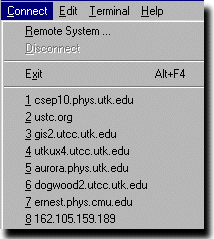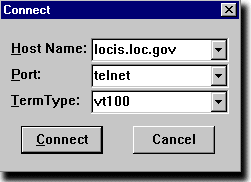|
Telnet
Microsoft Telnet
Microsoft Telnet |
Going Further
The program that we are going to use to implement telnet
in this discussion is Microsoft Telnet v1.0, which is included
as part of the Windows 95/98 operating systems. To find
the program, use the "Find" or "Search" utility on the Microsoft
Main Menu.

Initiating a Telnet
Session
When you launch MS Telnet, a terminal window is opened.
This is where you will be able, once connected, to type
commands directly to a remote computer. Move your mouse
to the top of the window to display the "Connect" pulldown
menu; it should look similar to the figure at the right.
Drag down to highlight "Remote System", and release. The
resulting popup "Connect" login screen looks like the figure
below.
You can make a connection to the Library of Congress by
typing into the "Host Name" window of this popup the telnet
address, and clicking the "Connect" button at the bottom
of this window. In the example shown, the address is locis.loc.gov.

Try typing this address into the login window for MS Telnet
and see what happens. You may exit from the resulting telnet
session by choosing "Disconnect" from the telnet "Connect"
menu. (This leaves the telnet window open so you can then
use "Remote System" in the menu to log into another address
if you wish. If you want to leave the program, select "Exit"
from the "Connect" menu or click the close button at the
upper right of the telnet window.)
This is an example of a telnet login that does not require
a password, because it has been set up to allow "Anonymous
Logins"; that is, it permits logins from people who do not
have accounts on the computer with the IP address locis.loc.gov.
Other Microsoft Telnet
1.0 Features
Microsoft Telnet V1.0 is a very straightforward implementation
of telnet, and as such does not have a lot of bells and
whistles. One feature that you may want to take note of
is the fact the addresses for recent connections are stored
at the bottom of the "Connect" pulldown menu, as seen in
the first figure in this section. So if you wish to go to
one of these addresses, you can bypass the "Connect" popup
by simply dragging your mouse down to highlight the desired
address and releasing.
Another feature worthy of note is that you can have more
than one MS Telnet window open at the same time, so that
you can have multiple concurrent login sessions on the same
or different remote computers. The window title bar shows
the address that the terminal window is connected to. The
"Preferences" item under the "Terminal" window allows you
to set some display characteristics, such as text font and
cursor type, of each MS Telnet window. In addition, this
item lets you set the background color of the window, which
may also help you keep track of where you are if you are
running multiple login sessions.
At one time telnet was a very important means of obtaining
information on the Web. This function has almost entirely
been taken over by Web browsers now. It is still important,
however, as a way to log into remote machines, particularly
those running Unix operating systems. If you have an account
on such a system, you can use telnet to log into your account
from any machine supporting telnet on the Internet.
|